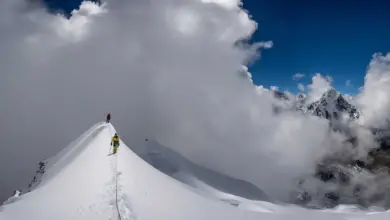Best season for Mount Kailash tour from Nepal – a detail guide

A tour to Mount Kailash requires careful consideration. The Mount Kailash is located in the remote area at the higher elevation. At that elevation, the varying weather conditions can affect the overall journey.
Mount Kailash is a sacred site where a large number of pilgrims go to visit it every year. Besides its religious and spiritual importance, the region around Mt. Kailash has diverse landscapes with natural flora and fauna.
However, you have to be cautious before going to the Kailash Mansarovar Yatra or Mount Kailash tour regardless of the reason you are visiting for. It becomes more important when it comes to your safety and the successful journey.
Various other factors can affect the journey other than seasonal conditions like accessibility, fitness, and personal preferences. However, the seasonal conditions remain on top of it.
There are altogether four seasons to know and plan your tour according to them. Spring and autumn are considered the best seasons but can we go for the Kailash tour in summer? Or in the winter?
Well, let’s find out the seasonal breakdown and best time and year for the Mount Kailash tour in this blog. At the end of the blog, there are the bonus tips needed for the Mt. Kailash tour, so, stay tuned.
Seasonal Breakdown
Spring Season
Spring season is considered one of the best seasons for the Mount Kailash tour. During this season, the weather conditions are more stable than the other seasons like summer and winter.
The average temperature around the Kailash region ranges from -5°C to 10°C during the spring season. But the nighttime temperature may drop below freezing temperature.
The snowfall decreases to almost zero during this season. The snow’s melting makes the paths easy to walk and travel. The paths become clear and there is no risk of snow cracks or crevasses.
The special thing about the spring season is that flowers like rhododendrons bloom during the season. It is the time when you can see the beautiful blooming flowers covering landscapes like a blanket.
Pros of the season
- The mild temperatures make the trekking/touring in the Kailash region comfortable.
- Due to the clear skies, the snowcapped peaks can be seen clearly.
- During the spring season, you can participate in the seasonal festivals and rituals.
- The rhododendron and other wildflowers bloom during this season.
- The weather is more stable during this season.
Cons of the season
- As the winter just ended, there may be a sudden snowfall in the early spring.
- The spring is one of the peak seasons, so you can miss the private trekking experience.
- Busier trails and accommodations as it is the peak season.
- Residue snow and ice at the higher altitudes can make it difficult to walk.
Summer Season
Summer season is not so popular but one of the favorable seasons for the Mount Kailash tour. The weather conditions may not be stable all the time but for the tour, this season can be a great option.
The average daytime temperature ranges from 8°C to 15°C, which is average in the Tibet area. The nighttime temperature drops around -5°C, which is manageable by wearing warm clothes and taking precautions.
However, there is the problem of monsoon during the summer season. The frequent rainfall may disrupt the tour. To face the monsoon and enjoy the clear views after rainfall, proper preparations and strategic planning are important.
Also, the summer season in the Kailash region presents unique cultural experiences. The majority of the people residing in the Kailash region are Tibetan. So, you will get to participate in the Tibetan festival and rituals.
Monsoon effects and travel difficulties
Monsoon poses challenges to travel to Mount Kailash and its surrounding region. The rainfall during the monsoon is frequent and heavy which leads to slippery trails and potential landslides. It may disrupt the road access.
However, the rainfall often occurs at night time due to which you can enjoy the post-rainfall views of the snowcapped peaks and lush green vegetation. This is one of the reasons travelers are attracted to the Kailash region even in monsoon season.
Still, you have to be cautious about the possible natural calamities. Pack warm clothing and don’t miss the rain gear. Check the weather conditions before heading out to any destination. Also, be flexible with the itinerary and be prepared for the possible disruptions.
Pros of the summer season
- The temperature ranges from 8°C to 20°C which is considered ideal for trekking in the Tibet region.
- The views of the snowcapped peaks and lush green forests just after the rainfall are breathtaking.
- Less crowds as the summer season is not the peak trekking season.
- Easy to find accommodation options
Cons of the summer season
- The monsoon rain especially in the July and august months caused road closures and landslides.
- Frequent cloud cover sometimes blocks the beautiful views of nature.
- The temperatures at the time may feel hotter sometimes.
Autumn Season
Autumn season is one of the best seasons for the Mount Kailash tour. The season’s specialty is during this season, the skies are clear, the weather is stable, and provides ideal trekking conditions.
The average daytime temperature ranges from 10°C to 15°C. At this range of temperature, trekking and traveling become comfortable. While the nights can be chilling. The temperature records a major drop at nighttime.
This season comes after monsoon so, the frequent rainfall is less. The scenery of the snowcapped peaks and green valleys became visible. The weather also becomes cool with a gentle breeze.
Pros of the autumn season
- The views of the snowcapped peaks are clear and visible due to the clear skies.
- This season is a good time for photography and sightseeing.
- The daytime temperatures are mild ideal for trekking and travelling in the Mount Kailash region.
Cons of the autumn season
- The nighttime can be chilling as this season is close to welcoming winter season.
- As this is the peak season, the crowds are more and may lack private trekking experience.
- In the late autumn, near winter season, some services may be reduced.
Winter Season
The winter season is not recommended for the Mount Kailash tour. It is due to the extreme cold even in the broad daytime. The temperatures can drop below -20°C. Also, the heavy snowfall blocks the paths making it difficult to travel.
Due to the high altitude, altitude sickness is high, especially during the winter season. There are highly unstable weather conditions with biting winds. This season limits accessibility and enjoyment.
The accommodations are also limited due to the freezing temperatures. Some opened teahouses may also have limited services if found. So, altogether, traveling during the winter season is not recommended.
Pros of the winter season
- The winter season brings heavy snowfall, which makes the landscapes more beautiful.
- The season may be the best for photographers and solitude seekers.
- There are fewer crowds as compared to peak seasons like autumn and spring season.
Cons of the winter season
- The freezing temperatures make outdoor activity hazardous and uncomfortable.
- Due to the heavy snowfall, the paths are often blocked by snow and ice.
- The services and facilities are limited during this season.
Best Time to go Mount Kailash tour for Saga Dawa Festival
The best time to go on the Mount Kailash tour to celebrate the Saga Dawa Festival is in June. The main festival day for 2025 is June 11. During this period trekking also became ideal.
In addition, the festival coincides with the full moon of the fourth lunar month in the Tibetan calendar. The festival preserves the enlightenment of the Sakyamuni Buddha.
During this time, a large number of pilgrims visit the Kailash region every year. It is the time to get exposure to the Tibetan culture and traditions. The travelers get a chance to participate in the festival celebrations and interact with the locals.
Best Year to go Mount Kailash tour
The best year for the Mount Kailash tour is considered the Horse Year or the Goat Year. According to the Tibetan calendar, this year comes once every 12 years. There is the local belief that if anyone completes the circumambulation of Mount Kailash during this year yields 13 times the merits and virtues.
Due to its spiritual and religious importance, this year holds a special place in the Tibetan traditions. Mount Kailash and Lake Mansarovar are sacred it self and this occasional year makes the journey more sacred and religious.
Essential gears and clothing for the best season
Choosing gears according to the season for the Mount Kailash tour is very important. While the winter season is not recommended, warm layered clothing is recommended. Similarly, light dry Clothes are best for the summer season.
For the best season, spring and autumn season, you should pack the following items.
•Trekking poles
•Warm hats with ear covers
•UV protective sunglass with a retainer
•Water-resistant gloves
•Layered clothes
•Woolen socks and sock liners
• Ankle support hiking boots
•A small backpack
•Small rent, sleeping bag, and basic toiletries
•A basic first aid kits
Final Words
Overall, the choice of the season highly depends on one’s preferences, skill set, and experiences. Those who are new to the tour may face difficulty while completing the kora of Mount Kailash.
The best seasons are of course, spring and autumn. The temperatures are mild and weather conditions are stable. Blooming flowers can only be seen during the spring season. The nights are chilling but can be manageable.
While the summer season is the hottest. Few pilgrims go to Mount Kailash tour during this season. To enjoy the views of lush green vegetation and the snowcapped peaks, then you must try summer once.
While winter season is not recommended due to its freezing temperature and heavy snowfall. So, prepare well, pack appropriate gear, and start your journey.
Source: https://www.exploreinnepal.com/mount-kailash-tour-from-nepal/



